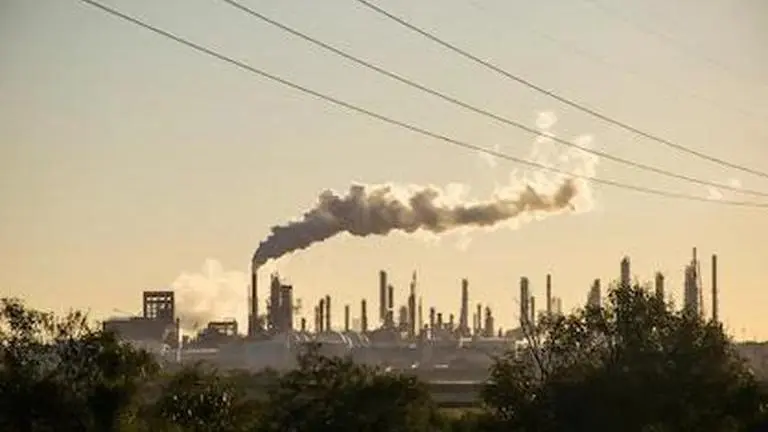Updated 29 April 2020 at 19:38 IST
Climate change threatens drinking water quality across the Great Lakes
“Do Not Drink/Do Not Boil” is not what anyone wants to hear about their city’s tap water. But the combined effects of climate change and degraded water quality could make such warnings more frequent across the Great Lakes region.
- World News
- 5 min read

This story is part of the Pulitzer Center’s nationwide Connected Coastlines reporting initiative. For more information, go to https://pulitzercenter.org/connected-coastlines-initiative.
“Do Not Drink/Do Not Boil” is not what anyone wants to hear about their city’s tap water. But the combined effects of climate change and degraded water quality could make such warnings more frequent across the Great Lakes region.
A preview occurred on July 31, 2014, when a nasty green slime – properly known as a harmful algal bloom, or HAB – developed in the
Tests revealed that the algae was producing microcystin, a sometimes deadly liver toxin and suspected carcinogen. Unlike some other toxins, microcystin can’t be rendered harmless by boiling. So the city issued a “Do Not Drink/Do Not Boil” order that
Advertisement
Local stores soon ran out of bottled water. Ohio’s governor declared a state of emergency, and the National Guard was called in to provide safe drinking water until the system could be flushed and treatment facilities brought back on line.
The culprit was a combination of high nutrient pollution – nitrogen and phosphorus, which stimulate the growth of algae – from sewage, agriculture and suburban runoff, and high water temperatures linked to climate change. This event showed that even in regions with resources as vast as the Great Lakes, water supplies are vulnerable to these kinds of man-made threats.
Advertisement
As Midwesterners working in the fields of
The Great Lakes together hold 20% of the world’s surface freshwater – more than enough to provide drinking water to
In 1970, after a century of urbanization and industrialization around the Great Lakes, water quality was severely degraded. Factories were allowed to dump waste into waterways rather than treating it. Inadequate sewer systems often sent raw sewage into rivers and lakes, fouling the water and causing algal blooms.
Problems like these helped spur two major steps in 1972: passage of the U.S.
The resulting cuts in nutrient and wastewater pollution have brought a quick decline in HABs – especially in Lake Erie, the Great Lake with the most densely populated shoreline. But new problems have emerged, due partly to shortcomings in those laws and agreements, combined with the growing effects of climate change.
Record high precipitation in 2019 caused flooding, property damage and beachfront losses in a number of coastal communities. Precipitation in 2020 is projected to be equally high, if not higher. Some of this is due to natural variability, but certainly some is due to climate change.
Another clear impact of climate change is a general warming of all five Great Lakes, particularly in the springtime. The temperature increase is modest and varies from year to year and place to place, but is consistent overall with
Some of these climate-related changes have converged with more direct human impacts to influence water quality in the Great Lakes.
Cleanup measures adopted back in the 1970s imposed stringent limits on large point sources of nutrient pollution, like wastewater and factories. But smaller “nonpoint” sources, such as fertilizer and other nutrients washing off farm fields and suburban lawns, were addressed through weaker, voluntary controls. These have since become major pollution sources.
Since the mid-1990s, climate-driven increases in precipitation have carried growing quantities of nutrient runoff into Lake Erie. This rising load has triggered
These blooms can make lake water smell and taste bad, and sometimes make it
So despite a half-century of advances, in many ways Great Lakes water quality is back to where it was in 1970, but with the added influence of a rapidly changing climate.
How can the region change course and build resilience into Great Lakes coastal communities? Thanks to a number of recent studies, including an intensive modeling analysis of
As one might guess, warming will continue. Summertime water temperatures are projected to rise by about another 5 degrees Fahrenheit by midcentury,
The analysis also projects an increase in extreme precipitation and runoff,
But recent success stories point to strategies for tackling these problems, at least at the local and regional levels.
A number of large infrastructure projects are currently underway to improve stormwater management and municipal sewer systems, so that they can capture and process sewage and associated nutrients before they are transported to the Great Lakes. These initiatives will help control flooding and increase the supply of “
Cities are coupling this “gray infrastructure” with green infrastructure projects, such as
Municipal water managers are also using smart technologies and improved remote sensing methods to create near-real-time warning systems for HABs that might help avert crises. Groups like the
Together these developments could help
Short of curbing global greenhouse gas emissions, keeping communities that rely so heavily on the Great Lakes livable will require all of these actions and more.
[Like what you’ve read? Want more?
This article is republished from The Conversation under a Creative Commons license. Read the original article here:
Published By : Associated Press Television News
Published On: 29 April 2020 at 19:38 IST
